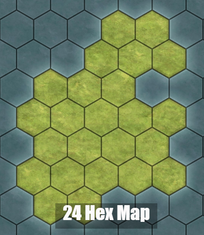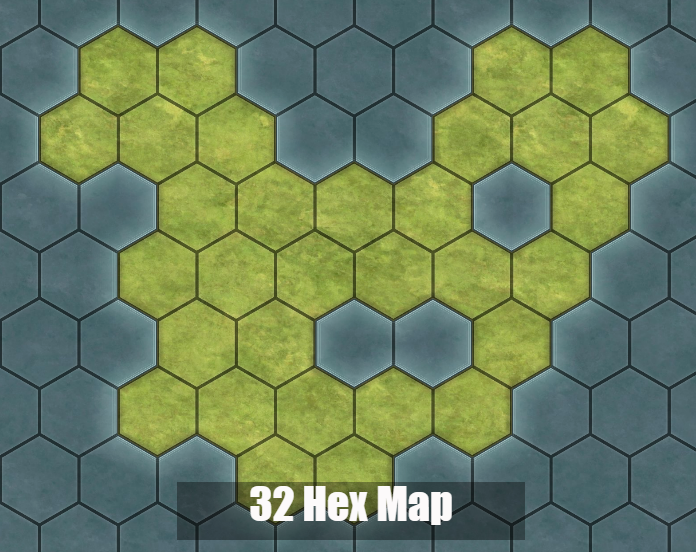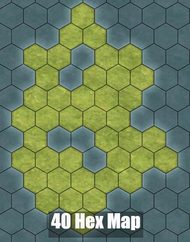Age of Sigmar - Path to Glory - Battle Realms - Hex Map System
These rules adjust or replace the Narrative Battle Path to Glory Rules for Age of Sigmar 3rd Edition where noted.
The Campaign Map
A Battle Realm campaign map is made up of hexes representing different terrain types:
Rivers/Lakes Roads Plains Hills
Mountains Cities Forests Ruins
There are some unique Hex types that represent the Fortresses belonging to the players, as well as some special objective hexes that may appear through the campaign. These will be described below.
Choose one of the following Campaign Map Sizes to determine how many of each terrain hex you will need, and some guidelines for the number of players each map can support.
Map Size Hexes/Type Number of Players Total Hexes
Small 3 4-6 24
Medium 4 6-8 32
Large 5 8-10 40
Players can take turns placing hexes down until you have reached the map size you wish to use, or the map can be generated using various map-building programs or using hex graph paper. It is recommended that the different terrain types should be evenly spaced to not give any particular spot an advantage. Example map layouts:
The Campaign Map
A Battle Realm campaign map is made up of hexes representing different terrain types:
Rivers/Lakes Roads Plains Hills
Mountains Cities Forests Ruins
There are some unique Hex types that represent the Fortresses belonging to the players, as well as some special objective hexes that may appear through the campaign. These will be described below.
Choose one of the following Campaign Map Sizes to determine how many of each terrain hex you will need, and some guidelines for the number of players each map can support.
Map Size Hexes/Type Number of Players Total Hexes
Small 3 4-6 24
Medium 4 6-8 32
Large 5 8-10 40
Players can take turns placing hexes down until you have reached the map size you wish to use, or the map can be generated using various map-building programs or using hex graph paper. It is recommended that the different terrain types should be evenly spaced to not give any particular spot an advantage. Example map layouts:
Picking your Amy
The rules for creating your Order of Battle are unchanged from the rules found on pages 304-311 of the Age of Sigmar Core Rulebook. The Battle Realm campaign rules assume that all players are beginning as either Vanguard or Warband starting size, but it can accommodate larger without issue.
The rules for creating your Order of Battle are unchanged from the rules found on pages 304-311 of the Age of Sigmar Core Rulebook. The Battle Realm campaign rules assume that all players are beginning as either Vanguard or Warband starting size, but it can accommodate larger without issue.
Placing your Fortress
At the beginning of a Battle Realms campaign players place their Stronghold hex along the outside of the map, more than 2 hexes away from a keep belonging to another player. Roll off to determine who gets to place their Stronghold first, and continue until all players have placed their Stronghold hex. When a new player joins the campaign after it has begun, they must place their keep more than 2 hexes away from a keep belonging to another player. If this is not possible, add more hexes to the map to allow for the new player to place their keep within these guidelines.
At the beginning of a Battle Realms campaign players place their Stronghold hex along the outside of the map, more than 2 hexes away from a keep belonging to another player. Roll off to determine who gets to place their Stronghold first, and continue until all players have placed their Stronghold hex. When a new player joins the campaign after it has begun, they must place their keep more than 2 hexes away from a keep belonging to another player. If this is not possible, add more hexes to the map to allow for the new player to place their keep within these guidelines.
Fighting Path to Glory Battles
Battle Realms battles are fought over the course of campaign rounds broken down into distinct phases. It is highly recommended to have all the players that are in the campaign present for the beginning of each round if possible for expediency.
Phase 1 - Initiative
Players compare the amount of unspent Glory Points they have to determine the initiative order each round, starting with the player that has the most, and rolling off if there is a tie.
Phase 2 - Declaring Attacks and Fighting Battles
Players take turns in initiative order to declare an attack against a hex adjacent to their currently controlled territory until all players have had an opportunity to declare an attack, or pass for the round. A single hex can only be attacked once per round, if a player chooses to attack a hex that is already being attacked that round by someone earlier in the initiative order, a multiplayer battle can be fought with the agreement of all players involved. The player that declared the attack on the hex first will have first choice of whether or not to gain control over the hex after the battle, if applicable. If the players do not agree to play a multiplayer battle, the new attack must be declared against a different hex.
Battle Realms battles are fought over the course of campaign rounds broken down into distinct phases. It is highly recommended to have all the players that are in the campaign present for the beginning of each round if possible for expediency.
Phase 1 - Initiative
Players compare the amount of unspent Glory Points they have to determine the initiative order each round, starting with the player that has the most, and rolling off if there is a tie.
Phase 2 - Declaring Attacks and Fighting Battles
Players take turns in initiative order to declare an attack against a hex adjacent to their currently controlled territory until all players have had an opportunity to declare an attack, or pass for the round. A single hex can only be attacked once per round, if a player chooses to attack a hex that is already being attacked that round by someone earlier in the initiative order, a multiplayer battle can be fought with the agreement of all players involved. The player that declared the attack on the hex first will have first choice of whether or not to gain control over the hex after the battle, if applicable. If the players do not agree to play a multiplayer battle, the new attack must be declared against a different hex.
If a player chooses to attack, follow these steps:
- Choose a hex adjacent to one of your controlled hexes to attack
- Check for defenders
- If the chosen hex is controlled by another player, that player is the defender.
- If the chosen hex is not controlled by another player, any player may choose to defend.
- If no player chooses to defend the target, no battle is fought and the Glory Point cost for acquiring the territory during the “Manage Your Territories” phase will be reduced by half (5GP instead of 10GP)
- If the hex is controlled by another player, the following changes are made to the process:
- Choose a suitable Battleplan, or Roll on the Battleplan Table to determine which battle is going to be fought
- Regardless of the battleplan, the player attacking the hex will always be the attacker/invader/disruptor/etc. The attacker must use an army drawn from their Order of Battle
- Regardless of the battleplan, the player that controls that hex will always be the defender/ritualist/ambusher/custodian/etc. The defender must use an army drawn from their Order of Battle
- If the hex is not controlled by another player, the following changes are made to the process:
- Choose a suitable Battleplan, or Roll on the Battleplan Table to determine which battle is going to be fought. The attacker must use an army drawn from their Order of Battle. The Battleplan can be drawn from faction-specific battletomes if appropriate.
- The defender’s forces are not drawn from their Order of Battle and instead can be any army of equivalent point value that the defender can muster. The defender’s forces do not gain Glory or Reknown, and are effectively representing NPC factions operating in the area.




